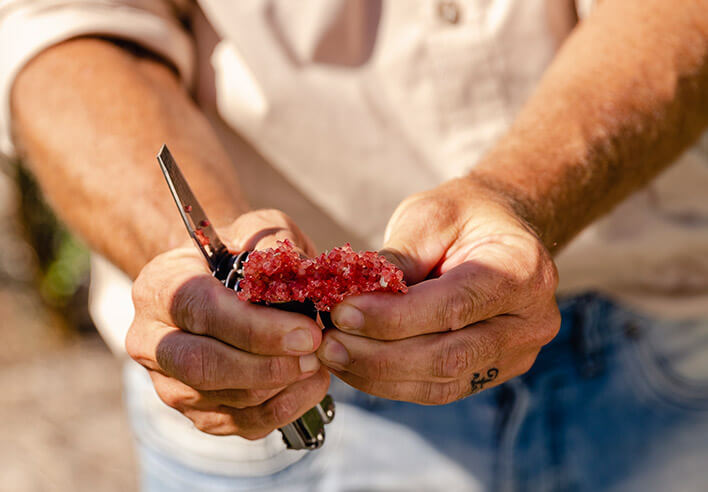

Native fingerlimes, also known as Citrus australasica, is a unique citrus fruit native to Australia. It is often referred to as “lime caviar” due to its small, round, bead-like vesicles filled with tart, tangy juice.
The fingerlime tree typically grows up to 20 feet in height and thrives in subtropical regions. It produces clusters of finger-shaped fruit that can range in color from green to pink, red, or even black. The skin of the fingerlime is thin and delicate, while the interior is packed with juicy pearls that burst with flavor upon being bitten into.
Fingerlimes have been a part of Aboriginal culture and traditional medicinal practices in Australia for centuries. Indigenous communities have utilized various parts of the fingerlime tree, including the fruit, leaves, and bark, for their therapeutic properties.
Fingerlime fruits were consumed by Aboriginal people as a food source, providing essential nutrients such as vitamin C. The sharp, tangy flavor of the fingerlime was enjoyed, and sometimes the fruit was used in traditional recipes and cooking. It is also believed that fingerlimes were collected and eaten as a snack while on hunting trips or during travels whilst going walkabout.
Apart from being a food source, fingerlimes also played a role in traditional Aboriginal medicine. The high vitamin C content of the fruit made it beneficial for boosting the immune system and preventing scurvy. The leaves and bark of the fingerlime tree were used for various medicinal purposes, depending on the region and cultural practices. For instance, they were used as a poultice on wounds to aid in healing or brewed into teas to alleviate cold and flu symptoms.
While the traditional knowledge and uses of fingerlimes by Aboriginal communities are diverse and varied, they are an important part of the Australian Indigenous cultural heritage. The fruit continues to be respected and appreciated for its physical and cultural significance in native communities. The fingerlime has gained popularity in recent years as a gourmet food ingredient. Its distinctive texture and intense citrus flavor make it a prized addition to raw seafood dishes, salads, desserts, cocktails, and even as a garnish for various culinary presentations.

The Salty Lime Co are Members of the Australian Native Fingerlime Alliance.
Grafted Finger lime trees begin producing fruit in the third year, but quantities remain limited until the fifth or sixth year, when they can produce up to 20 kilograms.
Trees generally only bear fruit every second year, although this can depend on climatic conditions and cultivar. This also has an impact on when different varieties mature, although this is generally between December and June.
Fruit is selectively picked every 10 days, by hand as finger lime is very delicate and susceptible to skin damage. Around 50 per cent of the harvest ends up as second grade or processing fruit. Fruit needs to be ripe when picked, as it does not ripen off the tree, cannot be picked when wet and the field heat needs to be removed as soon as possible.
Once harvested, finger lime has a 4-5 week shelf-life if stored in a cool room. As with other citrus, care must be taken to prevent chilling injury, so fruit should not be stored below 8°C. Whole finger lime or the pulp can be snap frozen and stored for 6-12 months and thawed without loss of shape or flavour. Food uses Finger lime pulp is unique with separate juice vesicles that resemble caviar. Sometimes referred to as crystals, these are compressed inside the fruit and burst out when the fruit is opened.
FLAVOUR PROFILE …Aroma of fresh zesty citrus with a hint of cooked citrus…Taste is citrus, tart with some astringency and bitterness…
In the wild, skin colour can range from yellow-green to crimson, purple, and black, and the colour of the fruit inside also varies. Pulp colours of green, yellow, red and pink have all been recorded. The attractive colours and caviar-like appearance make finger lime popular as a garnish, while its taste also sees it used in restaurants in seafood dishes and desserts, paired with Asian food or added to salads. Described as having a refreshing citrus, lime flavour, it is also used in dressings, jams and sauces, cordials and cocktails and can substitute wherever ordinary lemon or lime is used. Dried ground finger lime is also used in dukkah.